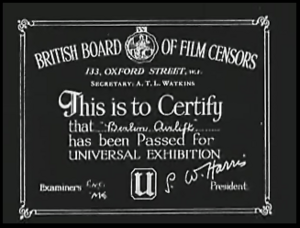British Board of Film Classification facts for kids
 |
|
| Formation | 1912 |
|---|---|
| Type | Non-governmental organization |
| Legal status | Public company limited by guarantee without share capital |
| Purpose |
|
| Headquarters | 3 Soho Square, London, W1D 3HD, England |
|
Region served
|
United Kingdom |
|
President
|
Natasha Kaplinsky |
|
Chief executive
|
David Austin |
|
Formerly called
|
|
The British Board of Film Classification (BBFC) is an organization that decides the age ratings for movies and videos in the United Kingdom. It was started by the film industry in 1912. The BBFC watches films, TV shows, and trailers before they are shown in cinemas or sold on DVD and Blu-ray.
The BBFC gives each film or show a rating, like U, PG, 12A, 15, or 18. This helps people, especially parents, decide what is suitable to watch. The organization is not part of the government. It also has a legal duty to classify video recordings and some video games.
Contents
How the BBFC Started
The BBFC was created in 1912. At the time, the film industry was new and growing fast. Some people were worried about the content of movies. Film companies decided to create their own board to set the rules. This was better than having the government or local councils do it for them.
The idea to form the board came after a film about the life of Jesus called From the Manger to the Cross caused a big debate. Some newspapers were angry about the film. This controversy led the film industry to create the BBFC, which started its work on January 1, 1913.
A law from 1909, the Cinematograph Act 1909, already required cinemas to have licenses from local councils. This law was first made for safety reasons, but it also allowed councils to control what films were shown. The film industry created the BBFC to have one set of rules for the whole country.
Early Rules for Films
Unlike movie rating boards in other countries, the BBFC did not have a written code at first. This made it hard for filmmakers to know what was allowed. In 1916, the BBFC president, T. P. O'Connor, listed 43 reasons why a film might need to be cut or changed.
These rules covered many topics. They included things like being disrespectful to sacred subjects, showing too much cruelty, or scenes that were considered rude. The rules also covered how crime was shown and even how people danced. Over time, some of these early decisions have seemed strange. For example, in 1928, the board called a surrealist film "almost meaningless" but also "objectionable."
Government Influence
The BBFC has always had a connection with the UK government. Before World War II, the BBFC worked with the Home Office to censor political ideas in films. The government worried that movies could be used for propaganda, so they discouraged controversial political topics in British films.
This was especially true in the 1930s. After Germany complained about a film showing the execution of Edith Cavell, the government put pressure on the BBFC. A system was created where British studios would send their scripts to the BBFC for approval before they even started filming.
After the war, the BBFC's role in political censorship became smaller. From the 1950s onwards, most debates about film ratings were about how they showed things like violence, rather than politics.
New Name and New Duties
In 1984, the board changed its name from the British Board of Film Censors to the British Board of Film Classification. This was to show that its main job was classifying films, not just censoring them. Around this time, it also began rating videos sold for people to watch at home.
Usually, a film gets the same rating for the cinema and for home video. But sometimes, the home video version gets a higher rating. This might be because of extra content, like bonus features. It is also easier for children to watch a video at home than to get into a cinema.
Rating Video Games
The BBFC also started rating some video games. In 1986, a text adventure game called Dracula was the first game to get a BBFC certificate. It was rated 15. The next year, another text adventure, Jack the Ripper, was the first game to get an 18 certificate.
In 1997, the game Carmageddon was the first to be refused a rating, but a changed version was later given an 18 certificate. In 2007, Manhunt 2 was also refused a rating. After some changes and legal appeals, it was eventually given an 18 certificate.
Since 2012, most video games in the UK are rated by the PEGI system. The BBFC now only rates games that have very specific types of content or include video footage that is separate from the game itself.
Working with Streaming Services
As more people watch movies and shows online, the BBFC has started working with streaming services. In 2019, Netflix and the BBFC announced a partnership. Netflix now uses BBFC age ratings for its content in the UK. This helps parents know what is suitable for their children to watch on the platform.
How the BBFC Works
The BBFC is funded by the fees it charges to classify films and videos. It is run as a not-for-profit organization. A team of examiners watches the media and decides on the rating.
Editing Films
Sometimes, the BBFC suggests cuts to a film so it can get a lower age rating. For example, if a film is on the borderline between a 12A and a 15, the film company might agree to remove a scene to get the 12A. Some cuts are required by law, such as anything that breaks the Protection of Children Act 1978.
Cinema and Video Ratings
For films in cinemas, local councils have the final say. Most of the time, they use the BBFC's rating. However, in the past, some councils have banned films that the BBFC passed, like Monty Python's Life of Brian in 1979.
For videos and DVDs, the BBFC's rating is legally binding. The Video Recordings Act 1984 says that all videos sold in the UK must be classified. It is illegal to sell a video to someone who is younger than the age on the certificate.
Current Age Ratings
The BBFC uses a set of certificates to rate films and other media. The current symbols were introduced in 2019.
What the BBFC Looks For
When deciding on a rating, the BBFC considers several key areas. These include:
- Discrimination: How the film treats issues of race, gender, or disability.
- Language: The use of swear words and other offensive language.
- Violence: How much violence is shown and how detailed it is.
- Dangerous Behavior: Actions that could be easily copied by young viewers, such as playing with dangerous items.
- Theme: The main ideas and topics in the film, and whether they are suitable for younger viewers.
The BBFC's rules change over time to reflect what the public thinks. For example, the use of strong language can lead to a higher rating. The film The King's Speech was rated 12A even though it had a strong swear word, because of the context in which it was used.
Violence is one of the most difficult areas. The BBFC looks at the context of the violence and whether it seems glamorous or fun. They are also careful about scenes that show dangerous acts that could be imitated in real life.
See also
 In Spanish: Agencia Británica de Clasificación de Películas para niños
In Spanish: Agencia Británica de Clasificación de Películas para niños
- Censorship in the United Kingdom
- Film censorship in the United Kingdom
- History of British film certificates
- List of films banned in the United Kingdom
- Motion Picture Association film rating system
- Press Complaints Commission









